Quantum computer: a big boost game. Lecture in Yandex
Every now and then we hear that the era of active use of quantum computing is not far off, that such systems will soon be available to specialists, including data analysts. But how much is left to wait really? Researcher at the Russian Quantum Center, Alexei Fyodorov, introduces the situation and tells how things are going with the development of quantum computers.
Under the cut - decoding and part of Alexey's slides.
Good day everyone. I want to thank the organizers. Since quantum technologies have become a topic of discussion in such a format, it means that this topic is perceived, begins to sound at a high enough level. Companies such as Yandex are leaders in the IT industry, and it’s very cool that quantum technology is on their agenda and in their area of interest. This is a kind of global trend. I am very glad that we are here today.
')
I work at the Russian Quantum Center and represent a team that is engaged in the development of IT products within the Russian Quantum Center. The quantum center started as a fundamental scientific institute, but very quickly in the development process, it began to engage in applied research in the field of quantum technologies, one of them is quantum cryptography, the project we are engaged in. And our speakers - I, Evgeny, Maxim, Nikolay - we all represent this team, so we will be glad not only to talk formally about the stated topic, but also to interact from the point of view that our interests overlap quite a bit. We will be glad to any questions in the field of quantum technologies, not limited to quantum computers.
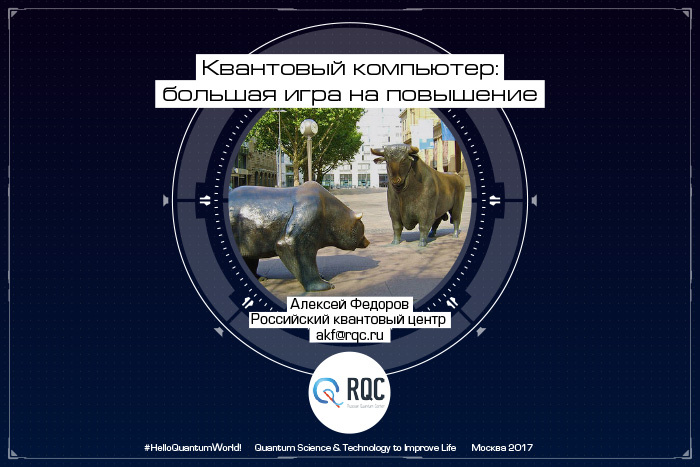
I placed this picture on my central slide. Do you know what this character is?
This is a statue, which is located next to the Frankfurt Stock Exchange and means two strategies of how to play the market: up and down. A quantum computer is the cornerstone of quantum technology, and now not only the state as the main investor of basic research, but also IT companies and major information technology manufacturers are joining its development. In this sense, they are playing to increase, investing heavily and efforts in the development of a quantum computer, because they see it as a new opportunity for a revolution in information technology. And the main message of my report is why quantum technologies and quantum computers are very cool, and why it is not just an interesting and beautiful idea, but really provides tremendous opportunities for the development of the entire IT industry.
That I, as a person who is engaged in physics most of the time, heard from programming and IT specialists? I heard about the following trends.

We often hear about a lot of new startups or such projects of already existing companies as the Internet of things, machine learning, big data and information security. These trends sound everywhere, they give informational reasons, but behind them, besides the beauty of algorithmic solutions, the beauty of mathematics, the beauty of programming, is real iron. And this iron is already quantum.
If you look at the development trends of not informational, but quantum technologies, now it is a transition from controlling collective quantum phenomena that underlie devices such as transistors and lasers to controlling individual quantum properties.
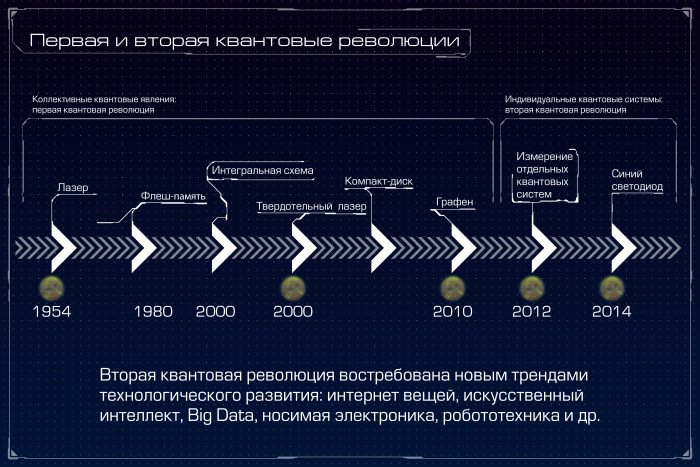
Roughly speaking, a laser is a control of a large number of particles of light, a large number of photons, and now we have learned how to control light, atoms, matter at the level of individual microscopic elements. This trend is observed from year to year, there are more and more experiments, proposals that use the laws on quantum physics already at the level of individual fundamental particles of matter. And here for me the most amazing is that it does not just come from the desire to learn basic science, but is also in demand in technological trends.
Quantum particles allow you to build a computer that will solve their problems faster. Quantum computers allow you to build communication systems that are better protected against listening. Quantum technologies make it possible to create more miniature sensors.
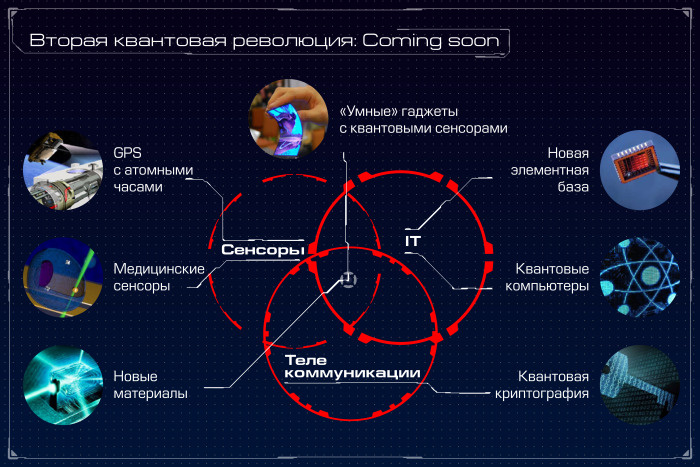
And all this underlies such applications as GPS, future medical sensors, new materials, which are in demand in the trends of information technology.
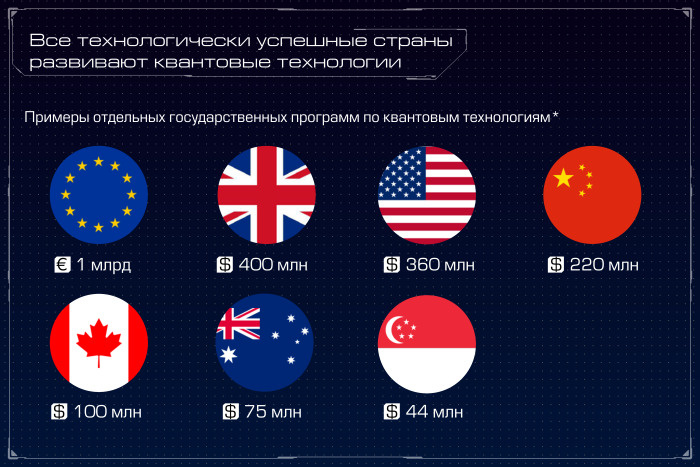
All technologically successful countries are currently actively engaged in the development of quantum technologies. A huge amount of funds is invested in these studies, and special programs are created to support quantum technologies. If you go back in history - we all remember the space race between the USSR and the USA.
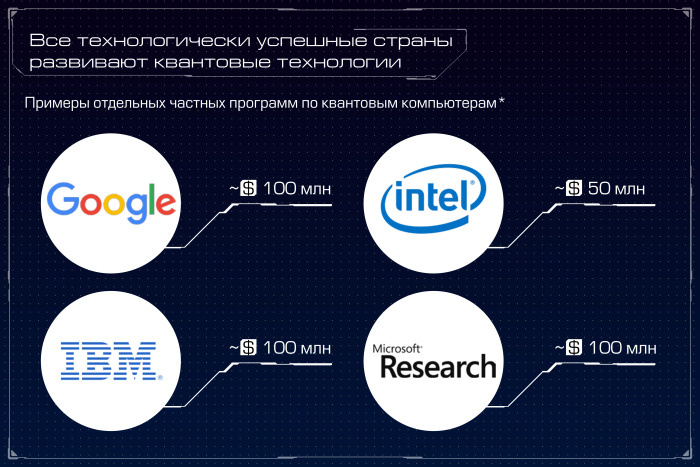
Not only states but also private companies participate in the quantum race. In total, Google, IBM, Intel and Microsoft have invested about $ 0.5 billion in the development of quantum computers in recent times, have created large laboratories and research centers.
Quantum technologies are still interesting because they imply a kind of research format, where fundamental science is very closely associated with applied research.
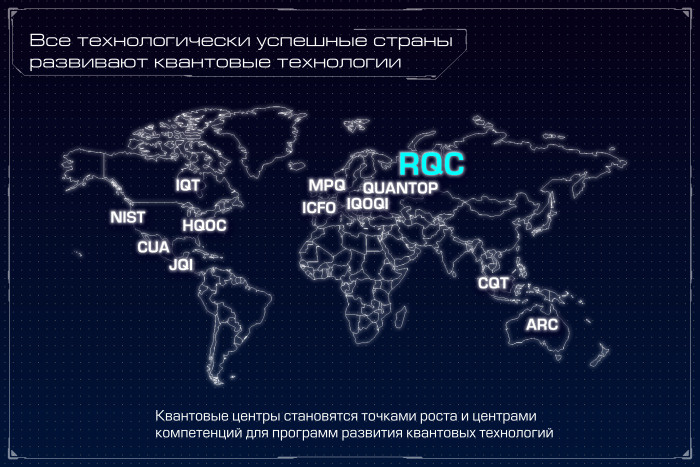
Here is a map of the world's quantum centers, which are points of competence and points of growth. In 2011, the Russian Quantum Center appeared on this map, which I represent. This is a fundamental scientific institution that has become an ecosystem where fundamental research coexists and stimulates the development of applied technologies.
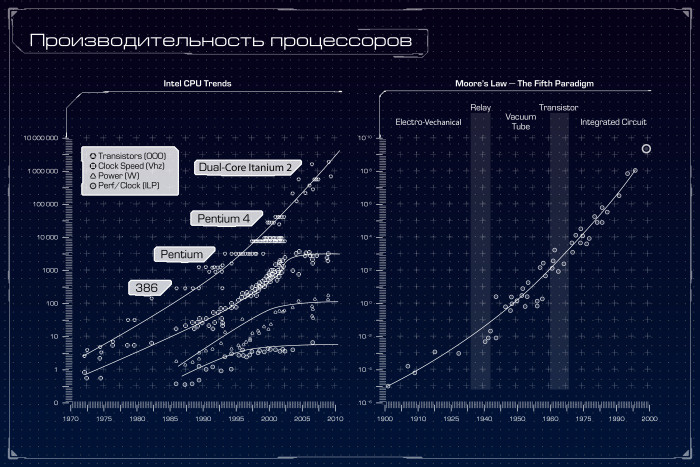
However, today we are talking about a quantum computer, and I want to create within the framework of this lecture a certain context, which allows us to understand why quantum computers are generally interesting and necessary.
Here is the well-known law of Moore, which expresses a certain trend of productivity growth of already existing computers. We know that computers are becoming more powerful from year to year, but behind this is a reduction in the element base, its miniaturization. Thanks to our progress in creating transistors, we can create less and less of them, and have everything closer to an elementary unit of area.
But, of course, this trend has a fundamental limit. It is due to physics.
We can hardly create a single atom transistor. This requires at least a few atoms. As far as I know, the world's smallest transistor consists of seven atoms. However, if Moore's law continues as it continues, then in 2020 we will need to create computers with a single atom transistor. And it seems impossible.
What can be done here? It is possible to increase productivity at the expense of other technologies, at the expense of cloud computing, parallelization, to come up with some element base that will allow you to get as close as possible to the limit of Moore's law, that is, to create the world's smallest transistor. This is a very cool task.
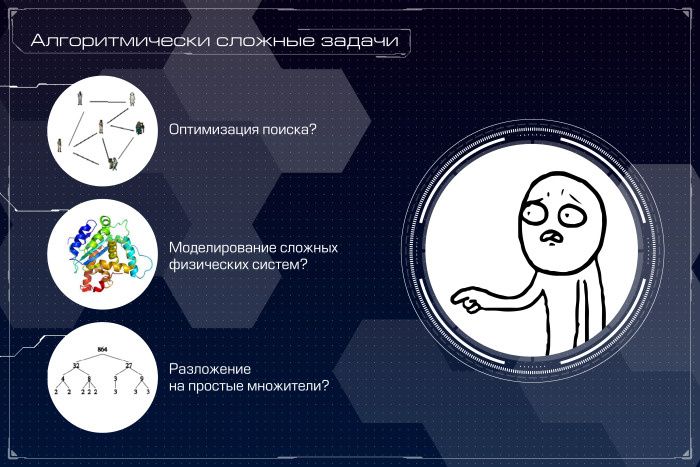
However, even if we come very close to Moore's law, we still have tasks that the classical computer solves very poorly. It is not for me among IT specialists to talk about this, but I will give examples of several tasks.
The first is the search optimization task. It is rather poorly solved on classic computers.
The second, closest to me and important - modeling of complex physical systems. For example, using simulation from first principles, it is very difficult to model some rather complex physical system. This requires a huge amount of resources.
There are various applied tasks that for a wide audience seem to be quite distant from practice, such as decomposition into prime factors. However, everyone knows their fundamental importance for various technologies.
And even if we get close to the limit of Moore's law, we cannot solve such problems.
Of course we can. But this will take a long time.
I would like to get a physical system that will allow solving these tasks in a more optimal way. It turns out that it exists and arises in the context of a quantum computer.
I peeped in the Nobel lectures of Andrei Heim, one of the creators of graphene, such an interesting idea. He told how he came to the idea of doing research in the field of graphene, using mental clouds. He heard about something, it was somehow processed in his head, and when he had accumulated enough mental clouds, he created the concept that it is very interesting to deal with two-dimensional carbon and graphene.

I believe that three mental clouds led to the concept of a quantum computer.
The first. It is not clear how to deal with computationally complex tasks. Is it really always difficult for us to model some kind of physical system? Or does the problem of factoring simply not have a reasonably efficient classical algorithm?
The second moment is more physical. It is connected with the study of the question that quantum physics, as one of the most accurate physical theories, imposes on the computational process for its limitations. For example, Richard Feynman and Charles Bennett investigated the question of what minimum amount of energy or heat is released when performing one elementary operation. Is it possible to create a computer that is the most productive and most economical in terms of energy release? How to create the smallest computer?
The third question is more about math. It is connected with the study of the question of what interesting properties the theory of information acquires, if we proceed from the description of classical objects in classical probability theory to the description of quantum objects, to quantum information theory. The banknote depicted here illustrates the idea of quantum money. This is one of the first concepts, which involves the use of some practical information technology. The fact is that if you create banknotes in which authenticity will be ensured by the creation of special quantum states, then due to the specific properties of quantum systems, such banknotes cannot be forged.
The second portrait here is a portrait of our compatriot Alexander Holevo. He is known worldwide as the creator of one of the fundamental theorems - the quantum information theorem or the Holevo theorem. Here, at the basis of the quantum theory of information, we have much to be proud of. Russian researchers maintain a good tradition of interesting publications, interesting results in this area.
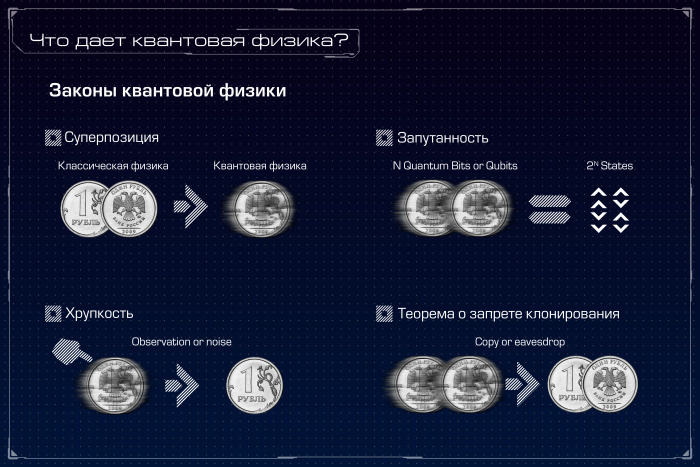
What does quantum physics do? What interesting consequences and tricks does she have that could be useful from the point of view of information theory or future calculations?
In the classical world, we are accustomed to thinking that if we have a state of some kind of physical system, then it must be uniquely defined by something. If we have a point in space, then we know that the system is in this point in space. In quantum physics, such a concept cannot be introduced. The point is that a quantum system, if it is not observed, is in a superposition of all possible states. In particular, if it has two admissible states, an eagle and tails, then until we have measured this state, this is both heads and tails. And only measurement gives us a guaranteed answer in what state the system is. Prior to measurement, the system is in a superposition state.
The second property is the property of quantum entanglement. In the quantum world, particles can exhibit very strong correlations, that is, their properties can be very strongly tied to each other, even if these particles are sufficiently strongly spatially removed. Explaining the concept of quantum entanglement, they often give an example of a mental experiment, when we had some particle with spin 0, it splits into two particles, we leave one in our laboratory, send the second to the Andromeda Nebula, we will know exactly the spin of a particle in the Andromeda Nebula. This is, in a sense, a manifestation of the properties of quantum entanglement, strong quantum correlations, which can be useful from the point of view of calculations.
The third thing is fragility. Quantum states are brittle compared to classical ones. And the measurement process is just a process of indignation. The question is whether this process of disturbance is deterministic. This is one of the key challenges to the creation of quantum technologies. It is very difficult to create a large quantum system, the elements of which will, on the one hand, interact well enough with each other and at the same time be sufficiently well protected from the environment that can destroy them.
Another interesting aspect is the cloning prohibition theorem. This is a forbidding theorem. If in the quantum world there is an arbitrary quantum state unknown in advance, then it cannot be copied, unlike the classical information. If there is a classic signal, it can always be copied. In the quantum world, an arbitrary quantum state cannot be copied. And this is a radical difference between quantum information and classical information.
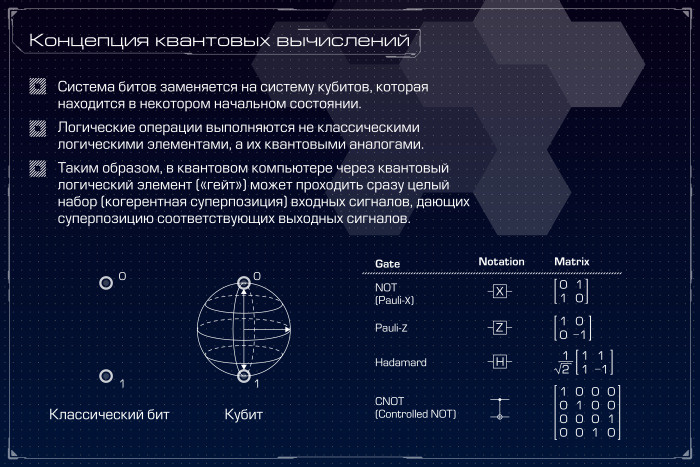
What is the concept of quantum computing? In principle, one can abstract to a certain extent from the complex laws of quantum physics and imagine the concept of quantum computations as follows.
The system of bits, which we are accustomed to in classical computers, is replaced by a qubit system. This is a two-level quantum system or an Eagle-tails-type system, when there are two possible states, and until the moment of measurement, the system is in superposition: at the same time and in this state, and in this with some probability.
All bits that we have are replaced with qubits. All logical elements from classical processes are replaced by quantum processes, and the result of calculations is obtained by measuring. Thus, in a quantum computer, processing of all possible implementation options is obtained at once, that is, you input not one bit, not zero or one, but all possible combinations - and perform all operations on this superposition. The result is a kind of quantum state. Measure it and get an answer.
In principle, at the conceptual level, this is the whole concept of quantum computing. The bits were replaced by qubits, the classical operations were replaced by quantum operations, as a result we get what we need to measure, we measure it many times and we get the answer.
This is what qubps can consist of. The point is that qubits can consist of a huge variety of different physical systems. We are used to the fact that the bit is encoded due to the voltage level. In quantum physics there is a variety of physical systems. This is a particle of light, and a particle of matter, and nuclear spins, and solid-state systems, which can be in such an interesting state of superposition. They have various advantages and various disadvantages. Here is the key fact today: no one fully understands what physical, elemental basis a quantum computer will be built on as a result. There is confidence that the so-called solid-state systems or systems with superconducting qubits are among the leaders, but about a month ago there was a competition between two quantum computers built on different physical principles, and it did not reveal any radical advantage of one system over another . Some systems scale better, others are easier to control, others are better protected from decoherence, from the process of interaction with the environment.

Let us, in the framework of the lecture, confine ourselves to two possible pictures. The first is the polarization of light. It is very simple to imagine, a particle of light is a very simple two-level physical model, and it is very popular in another application of quantum technologies: in the so-called quantum communications. The second picture is spin. Spin can be up or down, this is a qubit. Until we measured, this is a state of superposition. Plus or minus one second.
What I have already said is an interesting process that arises as a result of quantum computing. A new quantum state appears.
A certain zero and one superposition was applied to the input, and we carried out multiple procedures with it. The output is a superposition of zero and one.
To get an answer, we need to take a measurement, and it needs to be taken repeatedly. Quantum computations imply that a predetermined quantum state is repeatedly input. A transformation procedure and then measurement is performed on it. And measurement ultimately gives the answer.
This procedure of quantum measurements is quite complicated. This is a holivar topic even for experts in the field of quantum physics. I draw your attention to the fact that we have a regular rubric on the N + 1 website, which is called “Quantum Alphabet,” and we are discussing such subtle questions there, including the questions of quantum computation.
Why do we need all this? What will help us to make a quantum computer, what interesting chips will it give us? What is all this whistle with replacing bits with qubits, replacing logical operations and final results of calculations? What does this give?
This gives advantages to the whole class of tasks. The most interesting task for me, which a quantum computer does well, is the problem of factoring discrete logarithms, since it lies at the heart of systems with asymmetric cryptography. And every time we buy something on the Internet, our credit card information is encrypted using asymmetric cryptography algorithms, public key cryptography. They, in turn, are based on such problems, in particular, as discrete logarithmization and decomposition into prime factors. — , , . — .
, , , . , , , XXI . , , , , . , , - , , , .
, , , , , . .
. ? — .
— , . , . , Nature , — « » , 2017 - , . , .
. 5 25 . , .
, , D-Wave. , : . , . , , , D-Wave.
, . — . — , . , . . , - , , –100 . , . , . .
, IT-. — Google, , . . — . — D-Wave , .
, . , , Google, .
— IBM. - . , , , , .
— Microsoft Intel, — . - , - , , . . , . - . , , , . 2016 .
: , — , , . , , , . , , . , , , , . , , , — . .
, , . . — , , , .
— , QRate. . — , , , . Thanks for attention.
Under the cut - decoding and part of Alexey's slides.
Good day everyone. I want to thank the organizers. Since quantum technologies have become a topic of discussion in such a format, it means that this topic is perceived, begins to sound at a high enough level. Companies such as Yandex are leaders in the IT industry, and it’s very cool that quantum technology is on their agenda and in their area of interest. This is a kind of global trend. I am very glad that we are here today.
')
I work at the Russian Quantum Center and represent a team that is engaged in the development of IT products within the Russian Quantum Center. The quantum center started as a fundamental scientific institute, but very quickly in the development process, it began to engage in applied research in the field of quantum technologies, one of them is quantum cryptography, the project we are engaged in. And our speakers - I, Evgeny, Maxim, Nikolay - we all represent this team, so we will be glad not only to talk formally about the stated topic, but also to interact from the point of view that our interests overlap quite a bit. We will be glad to any questions in the field of quantum technologies, not limited to quantum computers.

I placed this picture on my central slide. Do you know what this character is?
This is a statue, which is located next to the Frankfurt Stock Exchange and means two strategies of how to play the market: up and down. A quantum computer is the cornerstone of quantum technology, and now not only the state as the main investor of basic research, but also IT companies and major information technology manufacturers are joining its development. In this sense, they are playing to increase, investing heavily and efforts in the development of a quantum computer, because they see it as a new opportunity for a revolution in information technology. And the main message of my report is why quantum technologies and quantum computers are very cool, and why it is not just an interesting and beautiful idea, but really provides tremendous opportunities for the development of the entire IT industry.
That I, as a person who is engaged in physics most of the time, heard from programming and IT specialists? I heard about the following trends.

We often hear about a lot of new startups or such projects of already existing companies as the Internet of things, machine learning, big data and information security. These trends sound everywhere, they give informational reasons, but behind them, besides the beauty of algorithmic solutions, the beauty of mathematics, the beauty of programming, is real iron. And this iron is already quantum.
If you look at the development trends of not informational, but quantum technologies, now it is a transition from controlling collective quantum phenomena that underlie devices such as transistors and lasers to controlling individual quantum properties.

Roughly speaking, a laser is a control of a large number of particles of light, a large number of photons, and now we have learned how to control light, atoms, matter at the level of individual microscopic elements. This trend is observed from year to year, there are more and more experiments, proposals that use the laws on quantum physics already at the level of individual fundamental particles of matter. And here for me the most amazing is that it does not just come from the desire to learn basic science, but is also in demand in technological trends.
Quantum particles allow you to build a computer that will solve their problems faster. Quantum computers allow you to build communication systems that are better protected against listening. Quantum technologies make it possible to create more miniature sensors.

And all this underlies such applications as GPS, future medical sensors, new materials, which are in demand in the trends of information technology.

All technologically successful countries are currently actively engaged in the development of quantum technologies. A huge amount of funds is invested in these studies, and special programs are created to support quantum technologies. If you go back in history - we all remember the space race between the USSR and the USA.

Not only states but also private companies participate in the quantum race. In total, Google, IBM, Intel and Microsoft have invested about $ 0.5 billion in the development of quantum computers in recent times, have created large laboratories and research centers.
Quantum technologies are still interesting because they imply a kind of research format, where fundamental science is very closely associated with applied research.

Here is a map of the world's quantum centers, which are points of competence and points of growth. In 2011, the Russian Quantum Center appeared on this map, which I represent. This is a fundamental scientific institution that has become an ecosystem where fundamental research coexists and stimulates the development of applied technologies.

However, today we are talking about a quantum computer, and I want to create within the framework of this lecture a certain context, which allows us to understand why quantum computers are generally interesting and necessary.
Here is the well-known law of Moore, which expresses a certain trend of productivity growth of already existing computers. We know that computers are becoming more powerful from year to year, but behind this is a reduction in the element base, its miniaturization. Thanks to our progress in creating transistors, we can create less and less of them, and have everything closer to an elementary unit of area.
But, of course, this trend has a fundamental limit. It is due to physics.
We can hardly create a single atom transistor. This requires at least a few atoms. As far as I know, the world's smallest transistor consists of seven atoms. However, if Moore's law continues as it continues, then in 2020 we will need to create computers with a single atom transistor. And it seems impossible.
What can be done here? It is possible to increase productivity at the expense of other technologies, at the expense of cloud computing, parallelization, to come up with some element base that will allow you to get as close as possible to the limit of Moore's law, that is, to create the world's smallest transistor. This is a very cool task.

However, even if we come very close to Moore's law, we still have tasks that the classical computer solves very poorly. It is not for me among IT specialists to talk about this, but I will give examples of several tasks.
The first is the search optimization task. It is rather poorly solved on classic computers.
The second, closest to me and important - modeling of complex physical systems. For example, using simulation from first principles, it is very difficult to model some rather complex physical system. This requires a huge amount of resources.
There are various applied tasks that for a wide audience seem to be quite distant from practice, such as decomposition into prime factors. However, everyone knows their fundamental importance for various technologies.
And even if we get close to the limit of Moore's law, we cannot solve such problems.
Of course we can. But this will take a long time.
I would like to get a physical system that will allow solving these tasks in a more optimal way. It turns out that it exists and arises in the context of a quantum computer.
I peeped in the Nobel lectures of Andrei Heim, one of the creators of graphene, such an interesting idea. He told how he came to the idea of doing research in the field of graphene, using mental clouds. He heard about something, it was somehow processed in his head, and when he had accumulated enough mental clouds, he created the concept that it is very interesting to deal with two-dimensional carbon and graphene.

I believe that three mental clouds led to the concept of a quantum computer.
The first. It is not clear how to deal with computationally complex tasks. Is it really always difficult for us to model some kind of physical system? Or does the problem of factoring simply not have a reasonably efficient classical algorithm?
The second moment is more physical. It is connected with the study of the question that quantum physics, as one of the most accurate physical theories, imposes on the computational process for its limitations. For example, Richard Feynman and Charles Bennett investigated the question of what minimum amount of energy or heat is released when performing one elementary operation. Is it possible to create a computer that is the most productive and most economical in terms of energy release? How to create the smallest computer?
The third question is more about math. It is connected with the study of the question of what interesting properties the theory of information acquires, if we proceed from the description of classical objects in classical probability theory to the description of quantum objects, to quantum information theory. The banknote depicted here illustrates the idea of quantum money. This is one of the first concepts, which involves the use of some practical information technology. The fact is that if you create banknotes in which authenticity will be ensured by the creation of special quantum states, then due to the specific properties of quantum systems, such banknotes cannot be forged.
The second portrait here is a portrait of our compatriot Alexander Holevo. He is known worldwide as the creator of one of the fundamental theorems - the quantum information theorem or the Holevo theorem. Here, at the basis of the quantum theory of information, we have much to be proud of. Russian researchers maintain a good tradition of interesting publications, interesting results in this area.

What does quantum physics do? What interesting consequences and tricks does she have that could be useful from the point of view of information theory or future calculations?
In the classical world, we are accustomed to thinking that if we have a state of some kind of physical system, then it must be uniquely defined by something. If we have a point in space, then we know that the system is in this point in space. In quantum physics, such a concept cannot be introduced. The point is that a quantum system, if it is not observed, is in a superposition of all possible states. In particular, if it has two admissible states, an eagle and tails, then until we have measured this state, this is both heads and tails. And only measurement gives us a guaranteed answer in what state the system is. Prior to measurement, the system is in a superposition state.
The second property is the property of quantum entanglement. In the quantum world, particles can exhibit very strong correlations, that is, their properties can be very strongly tied to each other, even if these particles are sufficiently strongly spatially removed. Explaining the concept of quantum entanglement, they often give an example of a mental experiment, when we had some particle with spin 0, it splits into two particles, we leave one in our laboratory, send the second to the Andromeda Nebula, we will know exactly the spin of a particle in the Andromeda Nebula. This is, in a sense, a manifestation of the properties of quantum entanglement, strong quantum correlations, which can be useful from the point of view of calculations.
The third thing is fragility. Quantum states are brittle compared to classical ones. And the measurement process is just a process of indignation. The question is whether this process of disturbance is deterministic. This is one of the key challenges to the creation of quantum technologies. It is very difficult to create a large quantum system, the elements of which will, on the one hand, interact well enough with each other and at the same time be sufficiently well protected from the environment that can destroy them.
Another interesting aspect is the cloning prohibition theorem. This is a forbidding theorem. If in the quantum world there is an arbitrary quantum state unknown in advance, then it cannot be copied, unlike the classical information. If there is a classic signal, it can always be copied. In the quantum world, an arbitrary quantum state cannot be copied. And this is a radical difference between quantum information and classical information.

What is the concept of quantum computing? In principle, one can abstract to a certain extent from the complex laws of quantum physics and imagine the concept of quantum computations as follows.
The system of bits, which we are accustomed to in classical computers, is replaced by a qubit system. This is a two-level quantum system or an Eagle-tails-type system, when there are two possible states, and until the moment of measurement, the system is in superposition: at the same time and in this state, and in this with some probability.
All bits that we have are replaced with qubits. All logical elements from classical processes are replaced by quantum processes, and the result of calculations is obtained by measuring. Thus, in a quantum computer, processing of all possible implementation options is obtained at once, that is, you input not one bit, not zero or one, but all possible combinations - and perform all operations on this superposition. The result is a kind of quantum state. Measure it and get an answer.
In principle, at the conceptual level, this is the whole concept of quantum computing. The bits were replaced by qubits, the classical operations were replaced by quantum operations, as a result we get what we need to measure, we measure it many times and we get the answer.
This is what qubps can consist of. The point is that qubits can consist of a huge variety of different physical systems. We are used to the fact that the bit is encoded due to the voltage level. In quantum physics there is a variety of physical systems. This is a particle of light, and a particle of matter, and nuclear spins, and solid-state systems, which can be in such an interesting state of superposition. They have various advantages and various disadvantages. Here is the key fact today: no one fully understands what physical, elemental basis a quantum computer will be built on as a result. There is confidence that the so-called solid-state systems or systems with superconducting qubits are among the leaders, but about a month ago there was a competition between two quantum computers built on different physical principles, and it did not reveal any radical advantage of one system over another . Some systems scale better, others are easier to control, others are better protected from decoherence, from the process of interaction with the environment.

Let us, in the framework of the lecture, confine ourselves to two possible pictures. The first is the polarization of light. It is very simple to imagine, a particle of light is a very simple two-level physical model, and it is very popular in another application of quantum technologies: in the so-called quantum communications. The second picture is spin. Spin can be up or down, this is a qubit. Until we measured, this is a state of superposition. Plus or minus one second.
What I have already said is an interesting process that arises as a result of quantum computing. A new quantum state appears.
A certain zero and one superposition was applied to the input, and we carried out multiple procedures with it. The output is a superposition of zero and one.
To get an answer, we need to take a measurement, and it needs to be taken repeatedly. Quantum computations imply that a predetermined quantum state is repeatedly input. A transformation procedure and then measurement is performed on it. And measurement ultimately gives the answer.
This procedure of quantum measurements is quite complicated. This is a holivar topic even for experts in the field of quantum physics. I draw your attention to the fact that we have a regular rubric on the N + 1 website, which is called “Quantum Alphabet,” and we are discussing such subtle questions there, including the questions of quantum computation.
Why do we need all this? What will help us to make a quantum computer, what interesting chips will it give us? What is all this whistle with replacing bits with qubits, replacing logical operations and final results of calculations? What does this give?
This gives advantages to the whole class of tasks. The most interesting task for me, which a quantum computer does well, is the problem of factoring discrete logarithms, since it lies at the heart of systems with asymmetric cryptography. And every time we buy something on the Internet, our credit card information is encrypted using asymmetric cryptography algorithms, public key cryptography. They, in turn, are based on such problems, in particular, as discrete logarithmization and decomposition into prime factors. — , , . — .
, , , . , , , XXI . , , , , . , , - , , , .
, , , , , . .
. ? — .
— , . , . , Nature , — « » , 2017 - , . , .
. 5 25 . , .
, , D-Wave. , : . , . , , , D-Wave.
, . — . — , . , . . , - , , –100 . , . , . .
, IT-. — Google, , . . — . — D-Wave , .
, . , , Google, .
— IBM. - . , , , , .
— Microsoft Intel, — . - , - , , . . , . - . , , , . 2016 .
: , — , , . , , , . , , . , , , , . , , , — . .
, , . . — , , , .
— , QRate. . — , , , . Thanks for attention.
Source: https://habr.com/ru/post/332106/
All Articles